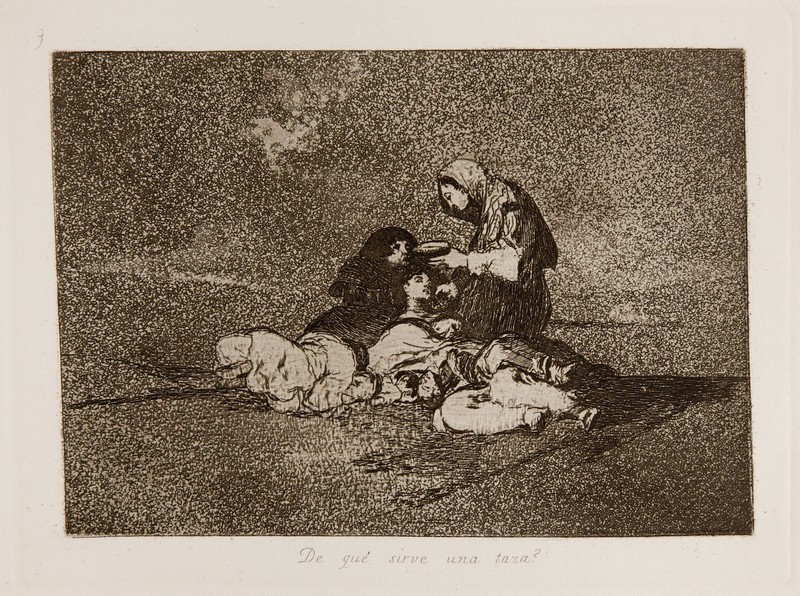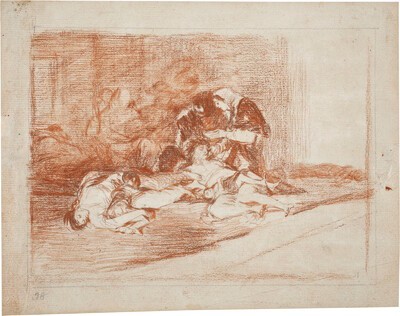- Cronología
- Ca. 1812 - 1815
- Dimensiones
- 157 x 207 mm
- Técnica y soporte
- Aguafuerte, aguatinta bruñida y lavis
- Reconocimiento de la autoría de Goya
- Undisputed work
- Ficha: realización/revisión
- 20 Dec 2010 / 02 Jun 2023
- Inventario
- 225
3 (on the lower left-hand corner of the plate).
Véase Sad presentiments of what must come to pass.
The second artist's proof shows that the aquatint extends right up to the edges of the page.
The title was handwritten on the print by Goya in the first and only series that is known to have been printed at the time the works were created, which the artist gave to his friend Agustín Ceán Bermúdez. Therefore, the title was etched into the plate at a later date and left unchanged as of the first edition of the Disasters of War printed by the San Fernando Royal Academy of Fine Arts in Madrid in 1863, after the printing of the series in the possession of Ceán Bermúdez.
There is a surviving preparatory drawing for this print which is housed in the Prado Museum in Madrid.
In the middle of a desolate landscape a woman helps others who are suffering from the terrible famine that affected Spain during the Spanish War of Independence, in particular between 1811 and 1812. One of the starving women in the centre of the composition lies prone on the ground with her eyes closed, exhausted, with the body of a child in her lap. Behind her, an older woman dressed entirely in black watches with a pained expression as the first figure helps the others.
Goya employs aquatint to render the sky and ground, achieving a granular effect in both areas to the point that it is difficult to tell where one ends and the other begins. Aquatint is also used to depict the women in the centre of the composition in great detail, while some areas on the body of the woman who is lying down and the one holding the cup in her hand have been left blank. There are no other elements to distract the eye from the figures being helped or spatial and temporal references: this gives the scene a markedly abstract, universal air.
The title of the print expresses the futility of the gesture, despite the good will of the person carrying out the act of helping the starving: the famine was extreme, and the available resources were scarce and insufficient.
This print, in which Goya continues to explore the theme of famine experienced during the Spanish War of Independence started in print no. 48, A cruel shame! (Cruel lástima), can be linked to no. 52, They do not arrive in time (No llegan á tiempo), which also depicts a merciful act in which women have a central role.
The plate is stored in the National Chalcography (cat. 310).
-
Goya and his timesThe Royal Academy of ArtsLondon1963cat. 66cat. 249
-
Francisco de GoyaMuseo d'Arte ModernaLugano1996exhibition celebrated from September 22nd to November 17th.cat. 59
-
Francisco de Goya: Maleri, Tegning, GrafikkNasjonalgallerietOslo1996from 10th to April 14th 1996cat. 147
-
Francisco Goya. Sein leben im spiegel der graphik. Fuendetodos 1746-1828 Bordeaux. 1746-1996Galerie KornfeldBern1996from November 21st 1996 to January 1997cat. 143
-
Ydioma universal: Goya en la Biblioteca NacionalBiblioteca NacionalMadrid1996from September 19th to December 15th 1996cat. 220
-
Francisco Goya. Capricci, follie e disastri della guerraSan Donato Milanese2000Opere grafiche della Fondazione Antonio Mazzottacat. 139
-
Goya et la modernitéPinacothèque de ParisParís2013from October 11st 2013 to March 16th 2014cat. 98
-
2022
-
Goya, grabadorMadridBlass S.A.1918cat. 161
-
Goya engravings and lithographs, vol. I y II.OxfordBruno Cassirer1964cat. 179
-
Vie et ouvre de Francisco de GoyaParísOffice du livre1970cat. 1092
-
Catálogo de las estampas de Goya en la Biblioteca NacionalMadridMinisterio de Educación y Cultura, Biblioteca Nacional1996cat. 272
-
ParísPinacoteca de París2013p. 149
-
Goya. In the Norton Simon MuseumPasadenaNorton Simon Museum2016pp. 114-151
-
Museo de Bellas Artes de Badajoz y Diputación de Badajoz2022p. 79

